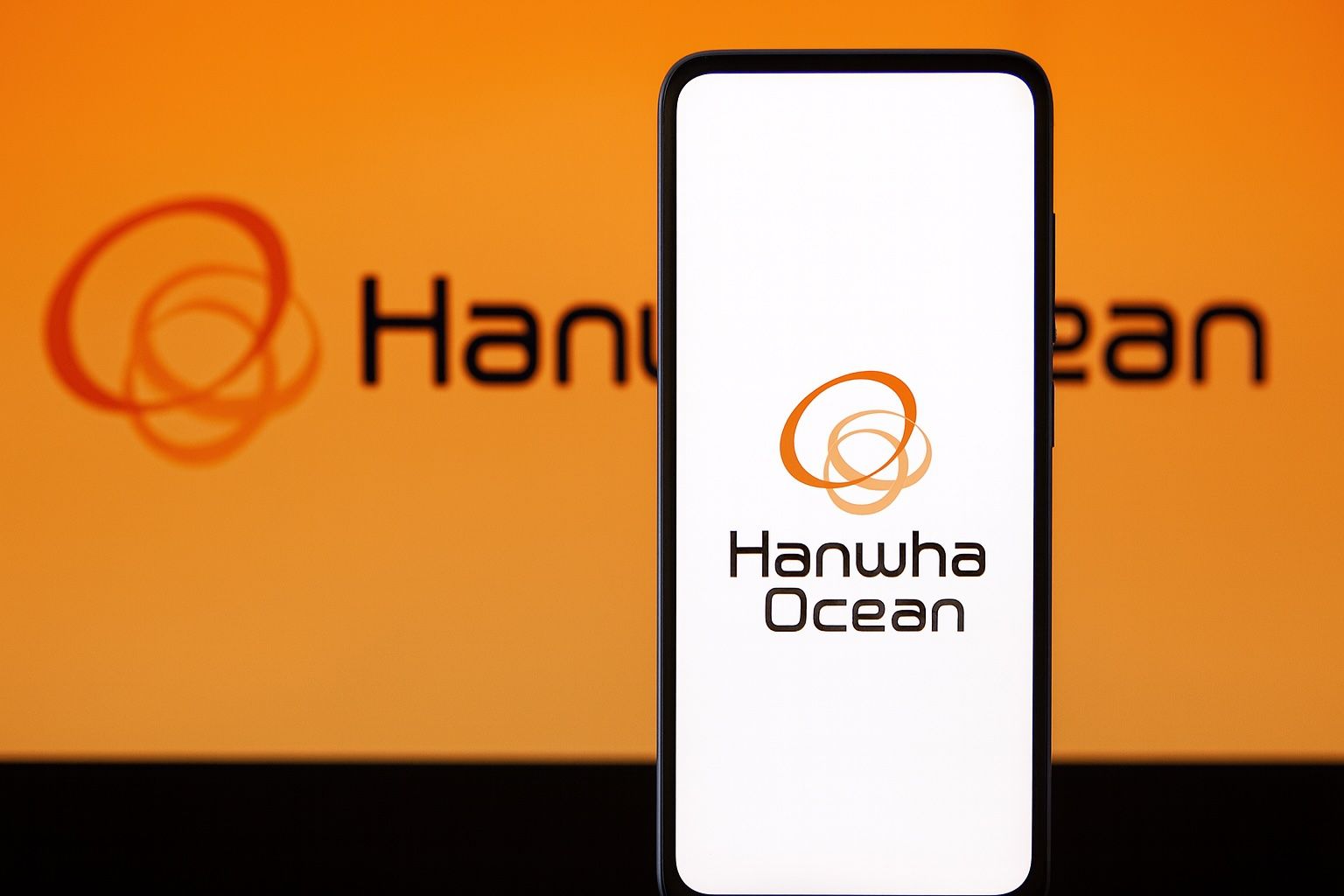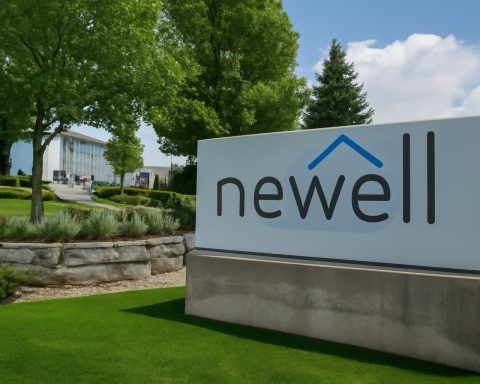- China Sanctions Hit – On Oct 14 Beijing barred Chinese firms from dealing with five Hanwha Ocean U.S. subsidiaries, part of a trade dispute with Washington [1]. Hanwha’s Seoul-listed shares plunged nearly 9% intraday, settling about 5.8% lower on the day [2].
- Government Reaction – South Korea says it is “in talks with China” to minimize the sanctions’ fallout [3]. Analysts warned China is “weaponizing shipbuilding” in the U.S.–China rivalry [4].
- U.S. Shipbuilding Push – Hanwha, which bought Philly Shipyard in 2024, plans a $5 billion U.S. investment to bolster American shipyards [5] [6]. This aligns with Washington’s drive to revive domestic shipbuilding with allied help.
- Green-Ship Orders – Hanwha won a major eco-shipping contract: Taiwan’s Yang Ming ordered seven 15,800‑TEU LNG dual-fuel containerships from Hanwha (delivered 2028–29) [7]. These vessels are designed as “ammonia-ready” to meet future emissions rules, making them part of Yang Ming’s new “green-energy” fleet [8].
- Naval Contracts & Partnerships – The company is deeply engaged in defense bids. It was named a qualified supplier for Canada’s new submarine program (CPSP) and met with 35+ Canadian firms at an October defense expo to forge partnerships [9] [10]. In Europe, Hanwha added a financing package to its bid for Poland’s 3-submarine ORKA program [11] and has pitched its KSS-III submarines (and even offered to modernize Greece’s subs) to multiple navies [12] [13].
- Tech Innovations – At June’s MADEX 2025 expo Hanwha showcased cutting-edge designs, from an 8,200-ton “Ocean 8000” destroyer concept with stealth and unmanned systems, to a 3,600-ton AIP diesel submarine that combines air-independent propulsion with lithium-ion batteries – claimed as a world first for endurance [14]. The firm also signed an MoU with steelmaker POSCO on “giga-class” ultra-strong naval steel [15] and an MoU with Polish yards (PGZ SW, Nauta) on joint submarine development [16].
- Industry Context – Hanwha’s moves come amid a global shipbuilding race. China now accounts for half of new ship orders (vs. ~30% for Korea) [17], and Western navies are urgently expanding fleets. Despite the stock blip, Hanwha’s backlog of international contracts in green shipping and naval projects underscores its growing global role.
Market Reaction & China Sanctions
On Oct. 14, Chinese authorities banned Chinese entities from working with five Hanwha Ocean subsidiaries in the U.S. (including its Philadelphia shipyard and related firms) [18]. Beijing accused these affiliates of “assisting… U.S. investigative activities” that threatened China’s security [19]. The move was widely seen as retaliation in the broader U.S.–China maritime trade dispute. Hanwha Ocean’s share price in Seoul instantly slid about 9% intraday, closing roughly 6% lower on Oct. 14 [20]. (Peer HD Hyundai Heavy also fell over 4% [21].)
Hanwha Ocean reacted by saying it is “closely reviewing” the potential business impact of the Chinese measures. South Korean officials swiftly engaged Beijing to contain any damage – Seoul’s presidential office confirmed it is “in talks with China to minimise the impact” on Hanwha’s U.S. operations [22]. Still, analysts cautioned the sanctions underscored geopolitical risk: “China just weaponized shipbuilding,” warned industry expert Kun Cao [23], highlighting how trade conflicts can quickly disrupt global maritime commerce.
Importantly, the timing coincides with Hanwha’s U.S. expansion plans. In 2024 Hanwha acquired Philadelphia’s Philly Shipyard (for $100M) and in August announced a $5 billion investment to expand docks there [24] [25]. This was part of a South Korea–U.S. push (dubbed “Make American Shipbuilding Great Again”) to rebuild U.S. shipyards. The Korean foreign ministry said the new government will continue supporting such defense exports, even as it assesses China’s move [26] [27]. Overall, most experts see limited long-term effect on Hanwha – but a reminder that global shipbuilding is now entangled in great-power rivalry.
Green Shipping Contracts
Beyond geopolitics, Hanwha Ocean is scoring big in eco-friendly shipbuilding. In early October 2025 it landed a contract with Taiwan’s Yang Ming Marine Transport to build seven 15,800‑TEU LNG dual-fuel container ships [28]. These will be the first in Yang Ming’s new “green-energy” fleet. Each ship is IMO compliant and built “ammonia-ready” (ABS Fuel Ready Level 1C) so that, after initial LNG operation, the engines can be converted to burn ammonia – a zero-carbon fuel with a mature supply chain [29] [30]. Hanwha Ocean even co-designed an advanced Type‑B LNG tank (1.0 bar pressure) to future-proof the vessels for shore-power or ammonia fueling [31]. Yang Ming’s order complements five sister LNG container ships (15,500 TEU) already on order, bringing its green dual-fuel total to 12 vessels.
This deal highlights Hanwha Ocean’s push into green technology and innovation in commercial shipping. The company has stressed eco-friendly LNG carriers in its portfolio, and the Yang Ming contract shows its design flexibly bridges current (LNG) and future (ammonia) fuels. Hanwha’s broader parent group is also active in related fields – for example Hanwha Power Systems is working on ammonia-capable marine engines. Industry observers note that global regulators are tightening emissions rules, and orders like Yang Ming’s position Hanwha well for the coming decarbonization wave.
Defense Contracts & Global Partnerships
Hanwha Ocean is a leading builder of naval vessels and is aggressively expanding abroad. Notably, it continues to push its KSS-III Batch II submarines (the 3,000‑ton Dosan Ahn Changho class) in multiple international competitions. In Canada, Hanwha Ocean’s variant has been shortlisted for the Canadian Patrol Submarine Project (CPSP), which will replace Canada’s Victoria-class subs. Having been named a “qualified supplier” in August 2025, Hanwha sent teams to Halifax’s DEFSEC Atlantic on Oct. 1–2 to court local industry. There it met with 35+ Canadian companies and agencies (including Irving Shipbuilding, Lockheed Martin Canada, ModestTree, etc.) to forge partnerships on everything from software (digital mock-ups) to hardware (fuel and array handling systems) [32] [33]. Hanwha emphasized that its KSS‑III design is already in active service and can be delivered quickly – four submarines could fully replace Canada’s fleet by the mid-2030s [34]. In short, the company is pitching a “sea-to-supply-chain” package of advanced subs plus Canadian industrial work.
In Europe, Hanwha is eyeing Poland’s Orka program (three new subs) and Greece’s new sub tender. Hanwha’s proposal to Poland includes its most modern KSS‑III Batch II boats, backed by an aggressive financing offer. As Reuters reports, Hanwha “added a comprehensive financing deal” to its bid to outcompete European rivals [35]. Hanwha’s Orka manager Jaemin Kim told media the package is built on “three core areas: providing robust financial support, helping enhance Poland’s defense capabilities, and deepening industrial cooperation” with Polish partners [36]. He boasted Hanwha could deliver the first submarine just six years after contract signing – one of the fastest schedules in the industry [37] – and could speed up follow-on deliveries if Warsaw wants. (South Korea’s government has quietly joined these efforts, working with Hanwha to tailor financing for buyers [38].)
Separately, Hanwha has been reported offering Greece its subs too. In Sept. 2025 local media noted Hanwha’s full proposal for four new KSS-III Batch II boats plus co-production in Greece, along with a plan to upgrade Greece’s existing German-design U214 subs [39]. (Other bidders in Greece include Naval Group and TKMS, showing Hanwha is now a serious competitor even in traditional European markets.)
These defense pursuits are bolstered by formal partnerships. At MADEX 2025 in June, Hanwha Ocean signed an MoU with Polish shipyards (state-run PGZ SW and Nauta) on joint submarine building and maintenance [40], explicitly preparing for Poland’s upcoming program. It also inked a technical MOU with Japan’s Kawasaki on destroyer communications (announced earlier in May). And in South Korea it continues building ties: for example, Hanwha recently signed an R&D MOU with POSCO to develop next-gen “giga-class” ultra-high-strength steel for naval hulls [41]. All these moves underscore that Hanwha is positioning itself not just as a supplier, but as a global partner providing technology transfer, co-production and finance to win big naval orders.
Innovations & Infrastructure
Hanwha Ocean’s own technological edge was on display at the June 2025 MADEX expo in Busan. There it unveiled striking concept designs: the futuristic OCEAN 8000 destroyer (8,200 tons, stealthy full-electric propulsion, large unmanned-systems hangar) and a 4,500‑ton export frigate based on Korea’s new Batch-III frigates [42] [43]. Hanwha emphasized these designs integrate its group’s advanced sensors (Hanwha Systems) and power systems (Hanwha Aerospace). Perhaps most eye-catching, Hanwha showcased a new 3,600‑ton diesel-electric submarine that it claims is “the world’s first” to combine both air-independent propulsion (AIP) and lithium-ion batteries [44]. This sub concept boasts the best underwater endurance of any current non-nuclear submarine, according to Hanwha. It signals how the company is pushing the envelope on endurance and stealth.
On the commercial side, Hanwha is also innovating infrastructure. For the Yang Ming ships, Hanwha co-developed a novel high-pressure LNG tank (1.0 bar) to boost safety and efficiency [45]. Its green LNG carriers (the firm claims some of the world’s most efficient) illustrate its commitment to eco-tech. Hanwha Ocean’s parent group has likewise invested in hydrogen and battery technology: for example, Hanwha Power Systems (affiliated with Hanwha Aerospace/Ocean) is developing ammonia gas turbines and fuel-cell engines for ships. Overall, industry analysts note Hanwha Ocean is leveraging Korea’s rich naval R&D base (formerly DSME) to stay at the forefront of ship tech – from autonomous vessels to zero-carbon fuel systems.
Strategic Deals & Restructuring
Hanwha Ocean’s strategy also involves strategic partnerships and acquisitions. Beyond subs and ships, it has been re-aligning its global footprint. In China it shut down a 2020 joint venture (DM-CMHI Heavy) with China Merchants Heavy, winding down that local project and moving offshore assembly to Singapore [46]. This reflects a shift of its offshore hub to Singapore and a pullback in Chinese ties amid US–China tensions. Conversely, it is building capacity elsewhere: it acquired Singapore-based Dyna-Mac (renaming it Hanwha Dyna-Mac) in late 2024, giving it offshore yards in Singapore and partnerships in Southeast Asia.
Domestically, Hanwha Ocean is expanding its capabilities too. It continues work on Korea’s largest LNG carriers and drillships, and it touts a new Total Operations & Maintenance Management System (TOMMS) for ships’ lifecycles (unveiled at MADEX [47]). The company emphasizes it can offer “integrated” solutions from design through sustainment, aiming to be a one-stop provider.
Finally, Hanwha Ocean’s financial profile has grown: with a market capitalization around $22 billion (KRW 26 trillion) in late 2025, it is firmly among Korea’s largest shipbuilders. Its expansion into defense and green ships is diversifying its revenue beyond traditional commercial orders. Still, the stock remains sensitive to external shocks (like trade sanctions) as this week proved. Investors and analysts will be watching how Hanwha Ocean weathers the China dispute and whether its pipeline of overseas contracts can translate into steady growth.
Expert Commentary & Outlook
Financial and defense analysts see these developments as mixed news. “The sanctions spooked investors,” notes a Seoul-based market analyst, but “Hanwha’s fundamentals are supported by strong backlogs in both commercial and military shipbuilding.” Defense industry experts emphasize that Hanwha’s aggressive bidding signals a maturing global presence. One European naval consultant comments, “Hanwha is now a credible competitor even against big incumbents; offering technology transfer and finance is how they’re gaining ground.” On the environmental side, maritime analysts applaud the dual-fuel ships’ design as “forward-looking,” fitting regulators’ tightening emissions rules.
In the international context, Hanwha’s story underscores the shifting maritime balance. China still leads in volume (half of new ships [48]), but South Korea’s two major shipbuilders (Hanwha Ocean and HD Hyundai) are challengers in warships and specialized vessels. Allied efforts (U.S., Japan, S. Korea) to rebuild Western shipyards make Hanwha an important partner for Washington and NATO, even as ties with Beijing strain. For now, Hanwha Ocean is navigating choppy waters – its stock took a hit on Oct. 14, but its broad portfolio of green-tech deals, defense contracts, and strategic partnerships offers a robust lifeline for future growth.
Sources: Recent coverage by Reuters and The Associated Press on the Oct. 14 Chinese sanctions and market reaction [49] [50]; Hanwha press releases and defense news (MADEX 2025, Polaris MoUs) [51] [52]; industry reports on submarine and green-ship contracts [53] [54] [55]; plus analysis quotes from experts [56] [57].
References
1. www.reuters.com, 2. apnews.com, 3. www.reuters.com, 4. apnews.com, 5. apnews.com, 6. www.reuters.com, 7. ammoniaenergy.org, 8. ammoniaenergy.org, 9. canadiandefencereview.com, 10. canadiandefencereview.com, 11. www.reuters.com, 12. www.reuters.com, 13. www.zona-militar.com, 14. www.hanwha.com, 15. cyprusshippingnews.com, 16. www.hanwha.com, 17. apnews.com, 18. www.reuters.com, 19. www.reuters.com, 20. apnews.com, 21. www.reuters.com, 22. www.reuters.com, 23. apnews.com, 24. apnews.com, 25. www.reuters.com, 26. www.reuters.com, 27. www.reuters.com, 28. ammoniaenergy.org, 29. ammoniaenergy.org, 30. ammoniaenergy.org, 31. ammoniaenergy.org, 32. canadiandefencereview.com, 33. canadiandefencereview.com, 34. canadiandefencereview.com, 35. www.reuters.com, 36. www.reuters.com, 37. www.reuters.com, 38. www.reuters.com, 39. www.zona-militar.com, 40. www.hanwha.com, 41. cyprusshippingnews.com, 42. www.navalnews.com, 43. www.navalnews.com, 44. www.hanwha.com, 45. ammoniaenergy.org, 46. www.seatrade-maritime.com, 47. www.hanwha.com, 48. apnews.com, 49. www.reuters.com, 50. apnews.com, 51. www.hanwha.com, 52. www.hanwha.com, 53. ammoniaenergy.org, 54. canadiandefencereview.com, 55. www.reuters.com, 56. apnews.com, 57. www.reuters.com





